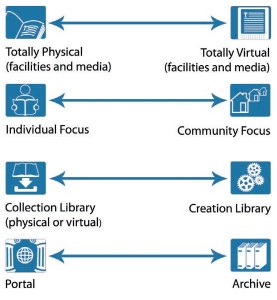The database I work with was down for a bit this morning, so I had little bit of time to peruse the ALA’s new Confronting the Future: Strategic Visions for the 21st Century Public Library.
I am intrigued by their notion of the Four Dimensions (see the illustration above). Besides being awesomely impossible to graph on a 2D chart, it’s a decent representation of the winds driving library evolution right now.
It’s also about strategic decision making. There is a certain amount of push-and-pull embedded in the 4D concept. A move on one spectrum will impact a library’s a place on one of the others. Can a “Creation” driven library also function well with an “Archive” and “Individual” focus?
The suggestion being: public libraries must choose what they want to be good at, since they cannot be good at everything.
Near the end of the paper, there are seven “Key Considerations”, of which the last three speak directly to this theme.
Fifth, in light of the strategic imperatives, the library must examine the alternative visions for its future, a range of which have been described in this policy brief. Then it must assess which of these visions respond to the strategic imperatives and are feasible given the external environment (view of the world) and in light of the competition as compared with the organization’s strengths (view of the library).
Sixth, a decision must be made on the basis of this information to set the strategic course toward a specific vision that combines the strategic choices made along each of the four dimensions described above…
Finally, while the strategy is being implemented, the set of assumptions represented by the view of the world and the view of the library must be monitored. Significant changes in those assumptions may warrant a mid-course correction in the strategy. Thus, even though it is the result of careful thought, no strategy can be considered immutable.
Basically, they’re saying that public libraries will require a combination of adaptability and specialization. This is something that is hard to achieve and let alone sustain, because adaptability and specialization can seem mutually exclusive.
Perhaps, it is better to think of specialization not as a destination, but as the slow process of evolving to new challenges. It’s an act of strategic risk taking where doing nothing will probably not bode well. Survival depends on being able to make the most of the changes that come your way. So, it’s good to be feeling around for a wedge into emerging niches.
Which niches should be pursued? This is the hard question, and “Confronting the Future” does not offer a lot of specifics. In this respect, the ALA’s paper works as a rallying point for public libraries trying to envision what sort change they want to embody.

No comments